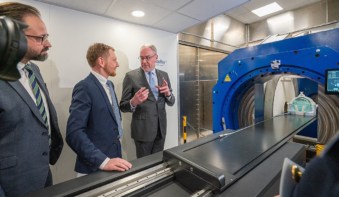
An array of low-voltage LEDs that emit short wavelength ultraviolet (UV) light could be used to kill harmful microbes on the skin and in the throat and nose – with minimal harmful side-effects to patients. The prototype device was developed by researchers at Germany’s Ferdinand Braun Institute and the Technical University of Berlin, who are currently testing its safety and efficacy.
Treating disease with antibiotics has led to the rapid evolution of drug resistant pathogens – which are believed to be responsible for about 700,000 deaths per year worldwide. One emerging solution to this global health problem involves killing harmful microbes on skin and other living surfaces using short-wavelength ultraviolet light. Unlike the longer-wavelength UV light currently used to kill microbes on inanimate surfaces, this UV light travels a very short distance in skin. As a result, it cannot penetrate the dead upper layers of the skin to reach the living cells below. Any minor damage to skin that does occur is easily managed by the skin’s natural healing response – minimizing any harmful side-effects.
While short-wavelength UV light can be produced by LEDs, components are not widely available on a commercial basis because of various technological challenges. In their study, the FBH and TUB teams developed a prototype device that incorporates emerging LED technology. It features an array of 118 LEDs spread over an area of 64 cm2 and emitting UV light at a wavelength of around 230 nm. The setup delivered a maximum irradiation power of 0.2 mW/cm2 over an area of 36 cm2, with 90% uniformity.
Assessing DNA damage
The researchers will now assess the performance of their device using tissue samples of both skin and mucous membrane. The latter is the soft lining found in the nasal cavity and the back of the throat, which are both preferred habitats for many harmful pathogens. Through these tests, they hope to determine the extent of damage to DNA caused by varying doses of light. They will also compare the pathogen-killing effectiveness of the radiation compared with other UV light at other wavelengths.

The potential of far-ultraviolet light for the next pandemic
The researchers believe their device promises to offer significant safety improvements on previous ultraviolet-based approaches, since the LEDs involved have low voltages, and convey little heat or strain to the skin. They hope their insights may soon lead to miniaturized devices which could be incorporated into endoscopes, allowing pathogens to be killed in small orifices, which are harder to access. Perhaps most importantly, it could also allow doctors to inactivate the SARS-CoV-2 virus responsible for COVID-19 inside the throat – the very spot where it first begins to replicate.



